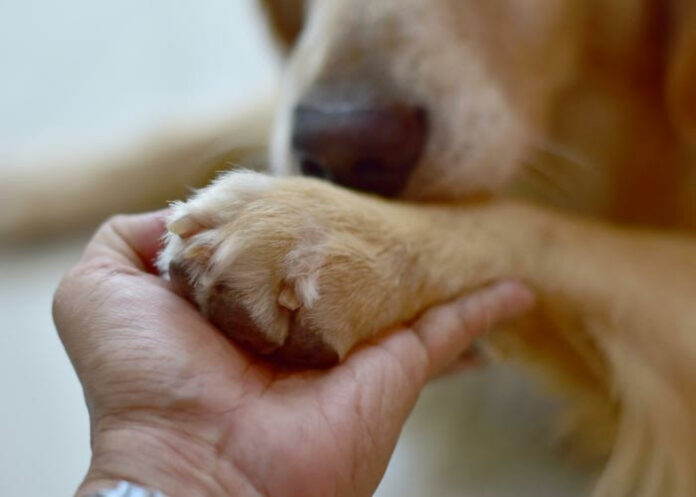The most recent research exploring the benefits of interactions with pets shows that prefrontal brain activation in healthy subjects increased with the rise in interaction closeness with a dog or a plush animal.
Previous studies have shown how oxytocin, the “love hormone”, is released when an owner and their dog interact through stimulation from gentle touch.
Now, using a small sample of 19 healthy adults the controlled trial measured participants’ brain activity over several sessions, both involving the presence of a dog and a plush animal. The results were publishd in PLOS ONE.
“Interaction with a dog stimulated more brain activity compared the the control condition,” the researchers wrote, “suggesting that interactions with a dog can activate stronger attentional processes and elicit more emotional arousal than interacting with a non-living stimulus”.
Previous studies into the physiological effects that dogs have on humans often used imaging technology such as PET scans — positron emission topography. While imaging scans have a variety of medical uses, they do have some drawbacks in a study such as this one. They can be loud, and lengthy, and participants may need to remain still. These are not characteristics that generally pair well with dogs, so previous studies frequently used pictures of dogs as stand-ins.
In this study, researchers opted to use functional near-infrared spectroscopy (fNIRS). Two electrodes were placed on participants’ foreheads to measure prefrontal cortex activity (which helps us regulate and process emotional interactions).
The sessions were held in a room at the neurorehabilitation centre REHAB Basel in Switzerland from February 2018 until July 2018.
To start with, participants were asked to face a white wall so they could first be measured in a neutral state. Then a dog was introduced during different sessions, where they could see the dog, sit beside it, and pet it after returning to a neutral state. Three dogs were involved in the study: a Jack Russel, a Goldendoodle and a Golden Retriever.
These sessions were then repeated, but with Leo, a stuffed lion with fur that was filled with a water bottle to match the temperature and weight of the dogs.
Best results when ‘petting’
According to the results, participants experienced increased brain activity when they interacted with the real dogs. This difference was largest for petting, which proved to be the most interactive condition. Moreover, the levels remained elevated even after the dog left.
While similar effects were noted initially with Leo, this later faded when the participants returned for more sessions.
Speaking to Healthline about the findings, Dr Joey Gee, a neurologist with Providence Mission Hospital in Orange County, California, said that dog-assisted therapies are “valuable for many chronic disorders and may be employed in settings where ‘calming’ is needed, such as with children and in long-term care facilities”.
Dogs are commonly used in animal-assisted therapy in children and adults. Researchers of the current study believe that “the knowledge gained will be crucial for (improving) effective animal-assisted interventions used to help treat conditions like dementia, depression and post-traumatic stress disorder (PTSD)”.
Study details
Effects of contact with a dog on prefrontal brain activity: A controlled trial
Rahel Marti, Milena Petignat, Valentine L. Marcar, Jan Hattendorf, Martin Wolf, Margret Hund-Georgiadis, Karin Hediger.
Published in PLOS ONE one 5 October 2022
Abstract
Background
There is a broad range of known effects of animal contact on human mental and physical health. Neurological correlates of human interaction with animals have been sparsely investigated. We investigated changes in frontal brain activity in the presence of and during contact with a dog.
Methods
Twenty-one healthy individuals each participated in six sessions. In three sessions, participants had contact with a dog, and in three control sessions they interacted with a plush animal. Each session had five two-minute phases with increasing intensity of contact to the dog or plush animal from the first to the fourth phase. We measured oxygenated, deoxygenated, and total haemoglobin and oxygen saturation of the blood in the frontal lobe/frontopolar area with functional near-infrared spectroscopy (SenSmart Model X-100) to assess brain activity.
Findings
In both conditions, the concentration of oxygenated hemoglobin increased significantly from the first to the fourth phase by 2.78 μmol/l (CI = 2.03–3.53, p < .001). Oxygenated haemoglobin concentration was 0.80 μmol/l higher in the dog condition compared to in the control condition (CI = 0.27–1.33, p = .004). Deoxygenated-haemoglobin concentration, total haemoglobin concentration, and oxygen saturation showed similar patterns.
Conclusion
Prefrontal brain activation in healthy subjects increased with the rise in interaction closeness with a dog or a plush animal. Moreover, interaction with a dog stimulated more brain activity compared to the control condition, suggesting that interactions with a dog can activate stronger attentional processes and elicit more emotional arousal than interacting with a nonliving stimulus.
Healthline article – Why Petting a Dog is Good for Your Brain (Open access)
See more from MedicalBrief archives:
Vaal therapy dogs project with child witnesses a ‘major success’
PTSD service dogs: Effective at warning of anxiety and disrupting it
Pets, especially dogs, linked with better cardiovascular health
Pet ownership associated with slower cognitive decline, reduced disabilities in older people

